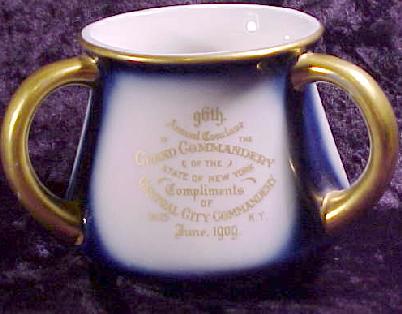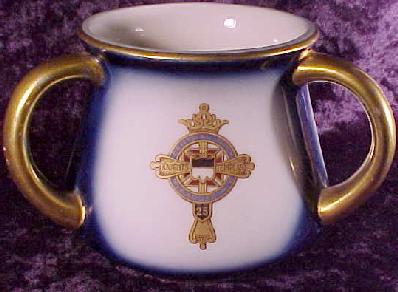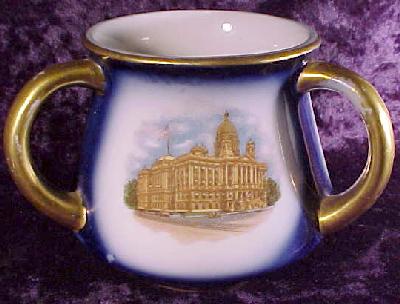|
Central City
Commandery No. 25
Three Handled
Loving Cup




This is without a doubt one of the most
beautiful of the Three Handled Loving Cups ever made. It was produced for the 96th
Annual Conclave of the Grand Commandery of the State of New York and states Compliments of
Central City Commandery, No. 25, Knights Templar, June 1909. It is decorated in a
very dark rich blue and gold lettering and trim and has colored transfers of the
Commandery Building and Jewel on each of the panels. It measures 3 1/8 inches tall
and 3 3/4 inches in diameter.
The Ceremony of the Loving Cup
An Ancient Masonic Ceremony of Sharing
Author
Unknown
This is an old tradition in Wellington Lodge No.
1385 usually performed at the conclusion of a banquet. It is a very old custom
which seems to have almost died out, at least in Craft Masonry. Wellington tries
to maintain this tradition and is famous for it.
Actually the Loving Cup should be passed after the Entered Apprentice song has
been sung. This is a ceremony handed down through the ages and need not be
limited to initiations, which Wellington does not do.
The procedure was for three Brethren to stand, two would unsheath their swords
and the third (middle) to hold up the cup by the two handles and to drink whilst
the two others defended him, one facing him and the other with his back to the
drinker’s back. Having taking his draught, the drinker then wipes the cup with a
napkin. The two brethren with thier backs together then turn to face each other
and the cup is handed over. The next brother in the line now stands to protect
the back of the drinker, and so on.
A later variation of the Loving Cup for toasting is the large two handled
wassail bowl or cup, usually pewter or silver and sometimes bearing the Lodge
badge or crest. At the festive Board it is passed round from Brother to Brother
around the table. The word “wassail” comes from the old English “Waes Hail”,
meaning “Be thou whole and of good health”. The custom of protection of the
drinker’s back is said to date back to Saxon times, when a man might be
treacherously stabbed whilst drinking - hence a friend or two defend him with
drawn swords. This may be borne out by the murder, in A.D. 979 of King Edward
(later known as Edward the Martyr), when he was so stabbed on the orders of his
stepmother, Elfrida, so that her own son, Ethelred could become King instead. He
was stabbed at the feast while drinking mead from a two handled loving cup by a
paid assassin.
There are many forms of the ceremony but the process of sharing, coupled with
mutual protection is the same — it reinforces the ancient Masonic bond we have
with each other.

|
